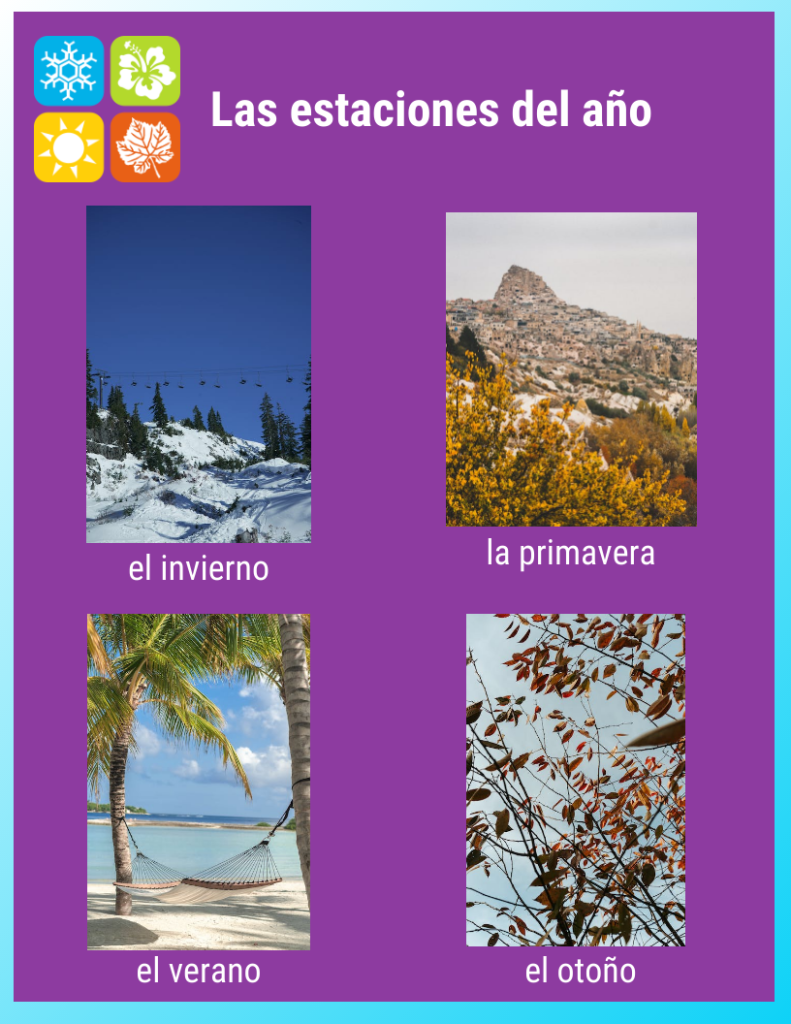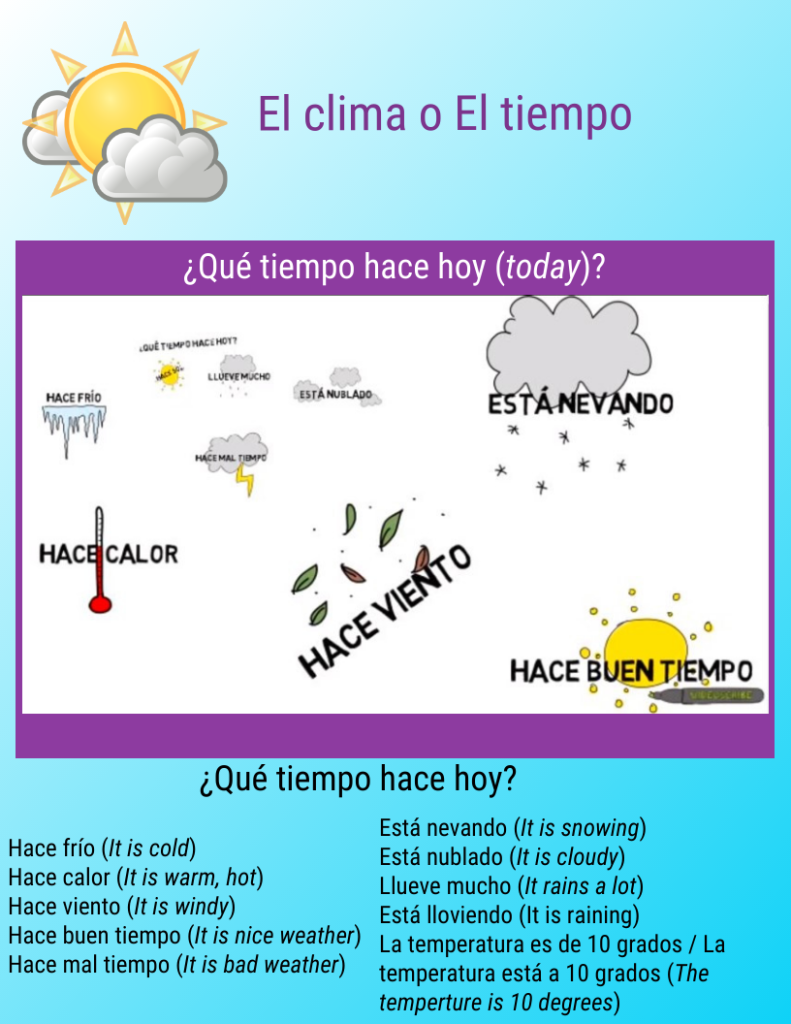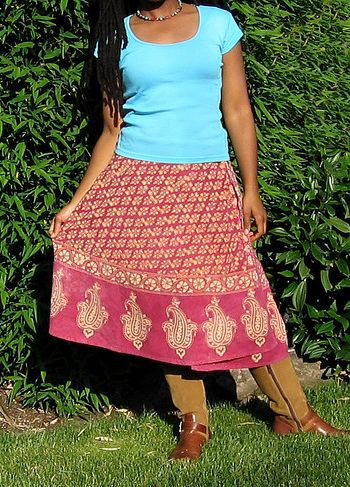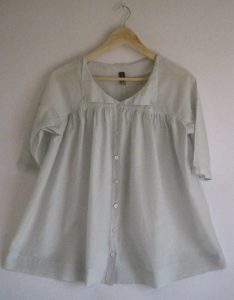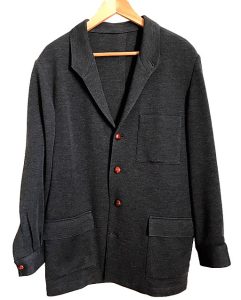Unidad 6 – Primera Parte (Part 1)
Vocabulario
(Vocabulary)
1. Las estaciones del año (The seasons of the year)
¡Más vocabulario!
Haz clic en la lista de vocabulario below to learn what they mean in English.
¡A practicar!
Basado en el video y en el vocabulario studied above, responde a las siguientes preguntas en español:
Copy and paste the following letters and symbols as needed.
á é í ó ú ñ Á É Í Ó Ú Ñ ¡ ! ¿ ?
- ¿A cuántos kilómetros de distancia está el sol del planeta tierra?
- ¿Cuánto tiempo viaja la tierra alrededor del sol?
- ¿Cómo se llama el fenómeno cuando los rayos del sol están cerca de la línea del ecuador?
- ¿Cómo se llama el fenómeno cuando los rayos del sol están lejos de la línea del ecuador?
- ¿En qué meses del año es el invierno en el hemisferio norte?
- ¿En qué meses del año es el verano en el hemisferio sur?
- ¿En qué fecha es el equinoccio de primavera?
- ¿En qué fecha es el solticio de verano?
- ¿Qué estación del año es en Uruguay cuando es otoño en Canadá?
- ¿Qué estación del año es en México cuando es invierno en Canadá?
2. La ropa en español (Clothing in Spanish)
Haz clic en la lista de vocabulario de la ropa below to learn what they mean in English.
| Ropa de verano y primavera: | Ropa de invierno y otoño: |
|---|---|
|
|
|
Haz clic en el enlace de LibreText que sigue para practicar la pronunciación de la ropa:
LibreText actividad 6.3 - Vocabulario- La ropa
Cómo usarlo
(How to use it)
Los verbos regulares llevar, usar y el verbo reflexivo ponerse are the most common verbs en español used with clothing.
| Preguntas: | Respuestas: |
| 1. ¿Qué ropa te pones en verano? | 1. Generalmente yo me pongo pantalones cortos. |
| 2. ¿Qué te vas a poner para la fiesta de graduación? | 2. Yo me voy a poner un vestido para la fiesta. |
| 3. ¿Qué ropa llevas a la playa? | 3. Yo llevo traje de baño, sandalias, lentes de sol y muchos pantalones cortos. |
| 4. ¿Qué ropa llevas hoy? | 4. Hoy yo llevo un abrigo porque es invierno. |
| 5. ¿Usas calcetines con sandalias? | 5. No, no me gusta usar calcetines con sandalias. |
En español the following word order is required when talking about colores de la ropa, material de ropa and other características de la ropa:
| Word Order | Example |
|---|---|
| 1. ropa + color |
|
| 2. ropa + material de ropa |
|
| 3. ropa + otras características |
|
Para comprar ropa, the following vocabulario is very useful:
| Actividades o verbos: | Conceptos o sustantivos: |
| costar (ue) (to cost) | la talla / el tamaño (size) |
| probarse (ue) (to try on) | el color (colour) |
| medir (i) (to measure) | el probador (fitting room) |
| pagar (to pay) | el pago (payment) |
| devolver (ue) (to return) | el recibo (receipt) |
| cambiar (to exchange) | el cambio (exchange) |
| comprar (to buy) | la tienda de ropa (clothing store) |
¡A practicar!
Haz clic en los siguientes enlaces de LibreText para practicar el vocabulario y comprensión oral sobre la ropa:
- LibreText actividad 6.4.A - ¿Qué llevan las mascotas? (What are the pets wearing?)
- LibreText actividad 6.4.B - Which picture corresponds to the speaker's description?
Mira el video y responde en español a las preguntas que siguen:
Copy and paste the following letters and symbols as needed.
á é í ó ú ñ Á É Í Ó Ú Ñ ¡ ! ¿ ?
- Es verano y el chico del video va a la playa, ¿qué ropa lleva él?
- Es invierno y el chico del video va a la escuela, ¿qué ropa lleva él?
¿Y tú?...
- ¿Qué ropa te pones tú en verano?
- ¿Qué ropa te pones tú en invierno?
Gramática
(Grammar)
1. El clima o el tiempo en español (The weather in Spanish)
El clima o el tiempo is a singular impersonal subject, meaning that it is never mentioned in the sentence.
- Hace frío (It´s cold)
- Llueve (It rains)
- Hace 23 grados (It´s 23 degrees)
- Está nevando (It is snowing)
Notice that you can say:
- Hace 23 grados
- La temperatura es de 23 grados
- La temperatura está a 23 grados.
Para hablar del clima en español, we need to differentiate between weather-related verbs and weather-related nouns. Los verbos hacer (hace) and haber (hay) are the most common verbs used with weather-related nouns such as:
- (el) calor (hot)
- (el) frío (cold)
- (la) nieve (snow)
- (la) tormenta/(las) tormentas (storm)
- (los) granizos (hails)
- (los) grados celcios (degrees celcius)
- (el) sol (sun)
Other weather-related verbs that describe the weather without a weather-related noun are:
- llover (to rain)
- nevar (to snow)
- granizar (to hail)
- chispear, lloviznar (to drizzle)
Finalmente, the verb estar is used as an auxiliary verb to form both present continuous weather conditions or express weather descriptors as in:
- está lloviendo (it is raining)
- está nevando (it is snowing)
- está nublado (it is cloudy)
- está soleado (it is sunny)
Aquí tienes un modelo de cómo hablar del clima using sustantivos and/or solely verbos en el presente simple indicativo (simple present tense) y el presente progresivo (present continous):
| Sustantivos climáticos (Weather nouns) |
Verbos climáticos en presente simple indicativo + sustantivos (Weather verbs in simple present tense + weather nouns) |
Verbos climáticos en presente simple indicativo (Weather verbs in simple present tense) |
Verbos climáticos en presente progresivo (Weather verbs in present continuous) Verb estar + adjetivos climáticos (Verb estar + weather adjectives) |
|---|---|---|---|
| el frío (cold) | Hacer + sustantivo Hoy hace frío. Hoy hace 10 grados. Hoy hace chaparrones. Hoy hace sol. Hoy hace buen tiempo. |
Llover (ue) (to rain) Hoy llueve. |
(Estar + gerundio) Hoy está lloviendo. Hoy está chispeando. Hoy está nevando. Hoy está granizando. |
| el calor (heat, hot) | Haber + sustantivo Hoy hay viento. Hoy hay 10 grados. Hoy hay tormenta. Hoy hay mal tiempo. |
Chispear / Lloviznar (to drizzle) Hoy chispea. Hoy llovizna. |
(Estar + adjetivo climático) Hoy está soleado. Hoy está nublado. |
| la nieve (snow) | Nevar (ie) (to snow) Hoy nieva. |
||
| los grados centígrados (degrees celcius) | Granizar (to hail) Hoy graniza. |
||
| la tormenta (storm) | |||
| las nubes (clouds) | |||
| los chaparrones / aguaceros / chubascos (hails) | |||
| el viento (wind) | |||
| el sol (sun) | |||
| el mal/buen tiempo (bad/good weather) |
¡A practicar!
Llena la tabla que sigue with a detailed description en español sobre el clima en tu ciudad en inverno, en verano, en primavera y en otoño.
¿Qué tiempo hace en tu ciudad?
Copy and paste the following letters and symbols as needed.
á é í ó ú ñ Á É Í Ó Ú Ñ ¡ ! ¿ ?
| En invierno... | En verano... | En primavera... | En otoño... |
|---|---|---|---|
¡Más práctica!
METEORORED tiempo.com es un sitio web en vivo that monitors el clima in different parts of the world.
Haz clic aquí en METEORORED tiempo.com and do a search for 2 different Spanish-speaking countries or cities in order to learn about su clima allí.
Using the material learned above to talk about el clima responde to la pregunta que sigue thoroughly en español:
- ¿Qué tiempo hace hoy en estos países / ciudades?
Copy and paste the following letters and symbols as needed.
á é í ó ú ñ Á É Í Ó Ú Ñ ¡ ! ¿ ?
2. Expresiones con "tener" (Expressions with "tener")
You already learned how to conjugate el verbo tener en presente simple indicativo and how to use it with:
- Los años de edad: Mi tío Andrés tiene 67 años.
- La posesión de objetos: Yo tengo una computadora portátil gris.
- La posesión de familiares: Yo tengo dos hermanas y un hermano.
- La expresión tener que to express obligación: Mi papá tiene que trabajar todos los
días.
El verbo tener is also used to describe sensations that relate to basic needs or as a result of the environment as in:
- Yo tengo calor (I am hot)
- Tú tienes frío (You-informal are cold)
- Nosotros tenemos hambre (We-males are hungry)
- Ellas tienen miedo (They-females are afraid)
- Él tiene sed (He is thirsty)
- Ellos tienen sueño (They-males are sleepy)
- Yo tengo razón (I am right)
- Nosotras tenemos cuidado (We-females are careful)
- Usted tiene suerte (You-formal is lucky)
Sensation related nouns used with "tener":
- calor (hot)
- frío (cold)
- hambre (hunger)
- sed (thirst)
- sueño (sleep)
- miedo (fear)
- razón (reason)
- suerte (luck)
- cuidado (care)
¡A practicar!
Haz clic en el enlace de LibreText below para practicar los usos y expresiones con "tener" studied above:
LibreText actividad Práctica 22 - Expresiones comunes con el verbo tener (Common expressions with the verb tener)
Cultura hispanohablante
(Spanish-speaking Culture)
La ropa en el mundo hispanohablante (Clothing in the Spanish-speaking world)
You already know that las personas hispanohablantes are ethnically diverse due to thousands of years of cultural contact as a result of colonization and human migration.
You also know that as a result of this cultural contact el español adopted words from different lexical backgrounds.
The following texto (text) is an extract from the Wikipedia article Spanish dialects and varieties.
Spanish dialects and varieties[1]
Different regional varieties of Spanish vary in terms of vocabulary as well. This includes both words that exist only in certain varieties (especially words borrowed from indigenous languages of the Americas) and words that are used differently in different areas. Among words borrowed from indigenous languages are many names for food, plants and animals, clothes, and household objects, such as the following items of Mexican Spanish vocabulary borrowed from Nahuatl.[2]
| Word | Engish translation |
|---|---|
| camote | sweet potato |
| pipián | stew |
| chapulín | grasshopper |
| huipil | blouse |
| metate | grinder, mortar and pestle |
In addition to loan words, there are a number of Spanish words that have developed distinct senses in different regional dialects. That is, for certain words a distinct meaning, either in addition to the standard meaning or in place of it, exists in some varieties of Spanish.
| Word | Standard meaning | Regional meaning |
|---|---|---|
| almacén | warehouse, department store | grocery store (Rioplatense Spanish, Chilean Spanish, Andean Spanish)[54] |
| colectivo | collective | bus (Argentine Spanish originally 'collective taxi', Chilean Spanish, Bolivian Spanish)[54]) |
| cuadra | stable, pigsty | city block (American Spanish)[54] |
| chaqueta | jacket | (vulgar) male masturbation (Central American Spanish)[55] |
| coger | to take, to catch, to start, to feel | (vulgar) to fuck, have sexual relations (Rioplatense Spanish and Mexican Spanish)[56] |
| concha | shell, tortoiseshell | (vulgar) cunt (Rioplatense Spanish, Chilean Spanish, Andean Spanish)[54] |
| peloteo | knock-up (in tennis), warm-up | fawning, adulation (Peninsular Spanish)[54] |
La ropa is a common vocabulario en español that relates to the country or region where el español is spoken.
As you read above, la palabra huipil means blusa en México.
The table below shows other variants of the word blusa en other países hispanohablantes:
| Prenda de ropa (garment) | México | Cuba | Chile | Nicaragua |
|---|---|---|---|---|
| La blusa | huipil | nailon | blusa | camisola |
The table below shows other variants of the word chaqueta in other países hispanohablantes:
| Prenda de ropa (garment) | Uruguay | Cuba | Chile | Guatemala |
|---|---|---|---|---|
| La chaqueta | saco, campera | traje | chaqueta | saco, chumpa |
The table below shows other variants of the word falda in other países hispanohablantes:
| Prenda de ropa (garment) | Argentina | Costa Rica | Cuba | España |
|---|---|---|---|---|
| La falda | pollera | enaguas | saya, falda | falda |
¡Aprender más!
- Haz una lista de 10 prendas de ropa en español from the vocabulary list you learned en la sección de vocabulario above.
- Do a google search to find out how each prenda de ropa from your list is called in at least 5 países hispanohablantes.
Por ejemplo:- ¿Cómo se dice los guantes en Bolivia?
- ¿Cómo se dice el impermeable en Colombia?
En mi opinión...
Can you think of any lexical variation in the names of clothing or any other lexical item with respect to the language or languages you speak? Reflect in English and provide examples.
Media Attributions
- Las estaciones del año © Constanza Rojas-Primus is licensed under a CC BY-NC (Attribution NonCommercial) license
- Qué tiempo hace hoy © Constanza Rojas-Primus is licensed under a CC BY-NC (Attribution NonCommercial) license
- Woman wearing a wrap skirt © Bandita is licensed under a CC BY-SA (Attribution ShareAlike) license
- Blusa © Terodáctila is licensed under a CC BY-NC-ND (Attribution NonCommercial NoDerivatives) license
- Teba_jacket © Barbudo Barbudo is licensed under a Public Domain license
- Spanish dialects and varieties by Wikipedia® is available under the Creative Commons Attribution-ShareAlike License 3.0 ↵
click on
let´s practice!
look at, watch
what follows, below
based on
answer
how many, for masculine entities
around
near, close to, around
they are far
date
link
pronunciation
to carry, to wear clothing
to use
to put on
for example
colours
clothing material
characteristics
for, to, in order to
to buy
links
oral comprehension, listening
that follow
weather
to talk
finally
here
how to speak
noun
verbs are words that represent an action or activity. For example: "to sing" is an action in infinitive form. In the sentence "I sing" the action is conjugated in the present indicative. In the sentence "I sang" the action is conjugated in past tense.
fill out
about
city
more practice!
live
her, his, your-formal, your-plural, and also, its for a non-human being
there
question
the years of age
the possession, ownership
must, to be obligated to
clothing
word
blouse
Spanish-speaking countries
jacket
skirt
let´s learn more!
make a list
in my opinion

